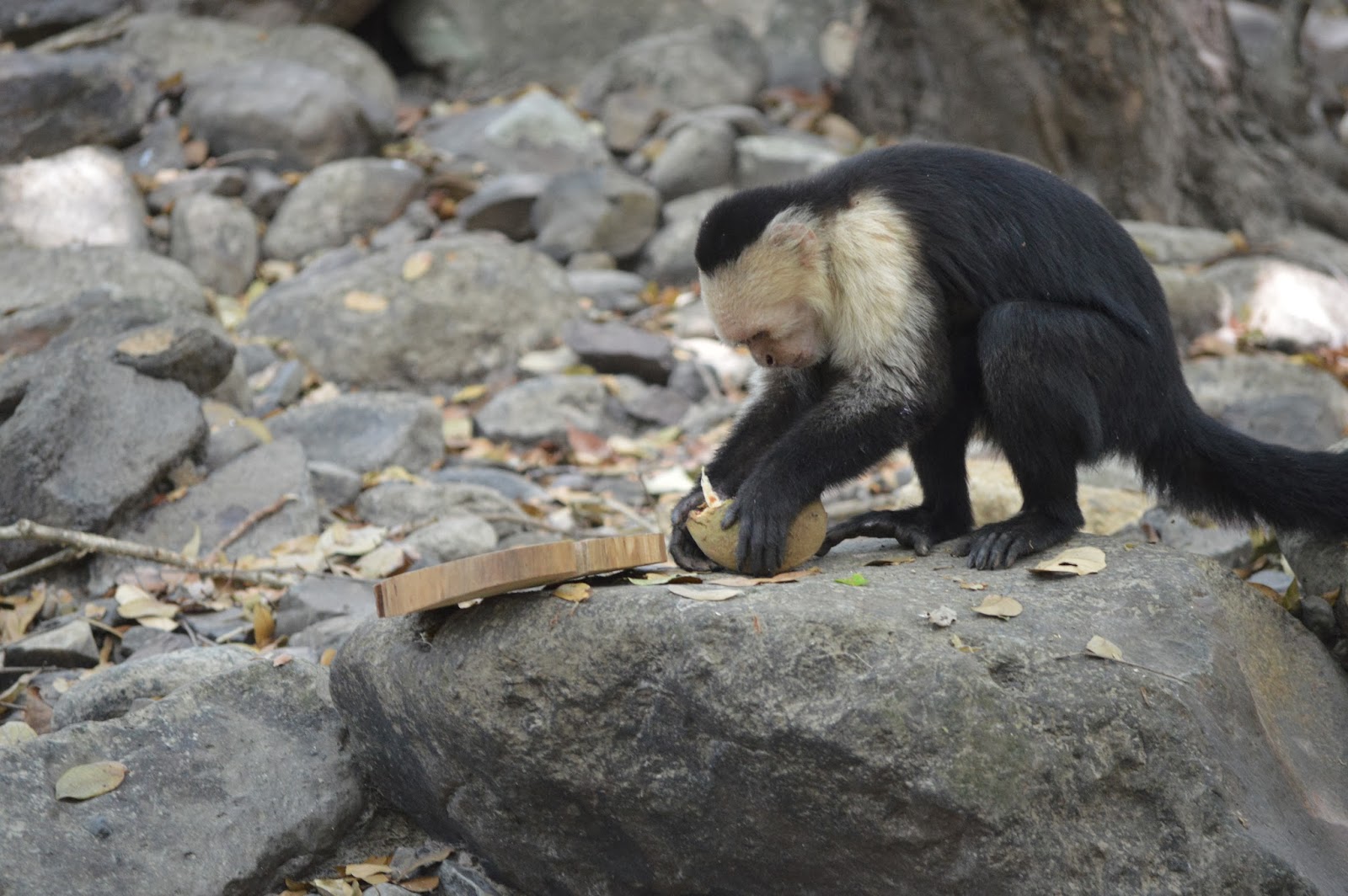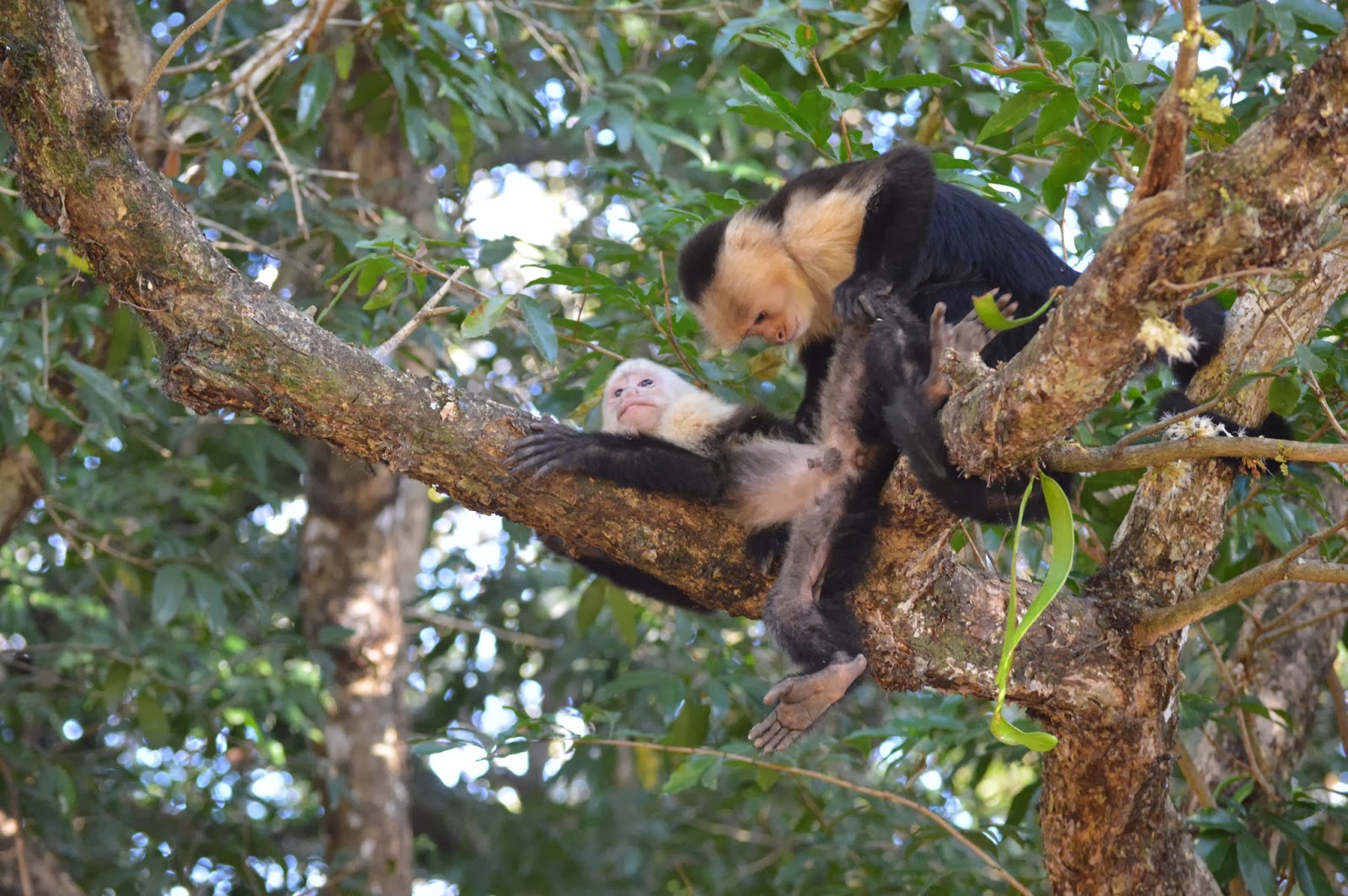I've actually spent less time than I would have liked Nicaragua-ing, and rather more time working on data entry, which requires me to listen to literally hours of my own recorded voice, multiple times. I'm even beginning to find myself quite annoying, if any of you fine people can imagine such a thing.
 |
| "Never!", I hear you cry |
Anyway I thought I would take opportunity to explain a bit more about this project and what I do here. It may be a bit more wordy than other posts, and probably quite boring to many of you, so feel free to skip it, although there will be some cool photos which you should definitely have a glance at.
 |
| Come, gather round, children. I have many stories to tell. |
I work at Lomas de Barbudal monkey project. If you follow that link you'll find out that the project was founded in 1990; and if you ever hear me complain about conditions here bear in mind that Susan Perry founded this place when there were no maps, no trails, and no GPS; when in order to follow the monkeys (who were unhabituated, mind, so very vigilant of humans and prone to staying high up in trees and running off very fast) you had to crash completely blind through the unfamiliar wilderness with nothing but guts and a machete to use as tools. Nowadays, if anything, the monkeys are a little too familiar around us as we regularly catch them in compromising situations.
 |
| "It's not what it looks like!!!" (it was totally what it looks like. They are half brothers. For shame.) |
Anyway this place is the longest continuously-running primate field project in the history of ever, which is super important and cool when studying a species like capuchins.
White-faced capuchins, if you did not click on that link or wikipedia them already, are very brainy, very long-lived monkeys who have been known to occasionally appear on Friends in the '90s. Interesting fact: the monkey on Friends was actually a female, while her character was male, but I for one applaud this bold rejection of oppressive gender binaries.
Capuchins have very complex social lives and also learn to forage hard to eat fruits by watching older individuals do so. The Lomas monkeys in particular are quite famous for demonstrating group specific learned behaviours: one of the most convincing examples of culture in a non-human species.
Capuchins, like chimps and other species including non-primate ones, have been shown to display culturally transmitted foraging behaviour, but the Lomas monkeys are famous for something else that they do. Certain groups, including the one that I study, play these very specific and slightly odd-looking games with each other. These generally involve taking a finger, a stick, a leaf, or some other object and inserting it into another monkey's mouth and having them bite down on it while the first monkey tries to pull it out. Sometimes they also insert fingers into each other's nostril in what is known as cultural hand-sniffing.
 |
| Quijote (right), the alpha, plays finger-in-mouth with his daughter Brizzle |
What is fascinating is that these games seem to be completely absent in most groups, where they simply have never caught on. In others, such as Flakes, the group I study, they play them all the time. Monkeys who have been taught to play go on to initiate the games with younger monkeys as they grow up.
If I can get geeky on you for a moment, I just want to really hammer home how cool this is. These games seemingly serve no purpose, except for perhaps bonding, which is generally achieved through grooming; and yet these traditions are perpetuated organically within a group.
We rightly think of culture and tradition as among the most important defining elements of humanity. They provide humans with our diversity, our shared meaning and sense of belonging; it lies at the root of language, art, and science. Each of us is so profoundly shaped by our culture that it's hard not to conclude that culture is what makes us human to begin with. And here are these little guys, with their strange traditions that must seem so alien to monkeys of different groups.
It really makes you think that maybe, if you got together enough of these capuchins, and put them in front of an infinite number of typewriters, one of them would eventually figure out that typewriters are obsolete and demand a MacBook Pro.
Anyway, as a reward for all that text here are a couple of the cutest monkeys being cute.
 |
| Mehitable, a.k.a *SQUEEE* |
 |
| Guinevere, a little boy, looking wistfully at his more masculine-named peers |
Ok, so, all this is well and fine, but you still don't know what I do over here. Well, first of all you should know I am not in the position of a standard assistant as advertised on the Lomas website. These assistants come for a year and participate in the general effort of the project, keeping tabs on the various groups and documenting the changing group dynamics, collecting data as is needed and with possibly a different emphasis depending on Susan Perry's current research interests and what her grants are based on. By the way, on the rather slim off-chance that this blog finds its way to someone who might actually be interested in doing something similar, these assistants are in short supply, so do think about applying if you want fieldwork experience.
Anyway I have been employed by a grad student, Brendan, who needs assistants for 5 months to help him with his research on social learning. Social learning, that is, learning from other individuals rather than by trial and error on your own, is a really big field in animal behaviour. Big questions include whether animals can imitate each other, whether or not they actively teach each other, what cues they pick up on while learning from others, and which individuals they decide to learn from. It's this question in particular that we are really looking at.
So when you're trying to study how monkeys learn from one another, you need several things:
- An activity that requires learning; this can be something artificially created, like pulling on a certain number of levers and strings to get a prize, or it can be something natural, like foraging for something tricky
- Naive individuals, that is, individuals who do not know how to do the thing
- Experienced individuals, who do know how to do the thing
Now there are two ways to go about getting these prerequisites. You can work with monkeys in captivity. The advantage of this is that you get to control everything. You can make sure that only some individuals are taught the activity, and you can monitor every time that the experienced individuals are in contact with the naive ones when they are performing this activity. In this way you get to see all the interactions and get a full picture of what is going on. Many interesting studies have already been conducted like this with capuchins in captivity, and the data collected is definitely worthwhile.
BUT you're still only seeing what goes on in captivity. And as such you never really know how these "unnatural" conditions affect the animals' behaviour. Plenty of animals are observed to do things in captivity which they never do in the wild, so you never know if you are witnessing something that truly reflects the evolutionary pressures that your animals have undergone, or whether they are just reacting and adapting to artificial conditions.
The other possibility is that you look at how they behave in the wild. This has also been done, including at Lomas. There are certain difficult-to-forage fruit which have been studied extensively, with every foraging technique noted and how the younger monkeys behave around the more knowledgeable older ones when foraging occurs.
BUT of course here you have no control. You can't monitor every single time a monkey picks up one of the fruits, nor do you know from day one who is experienced and who isn't. You can only get a snapshot, never the full picture.
And this is where Brendan's work is so ingenious. The group we study, Flakes group, is an offshoot of a larger group that split off and migrated to a different, only slightly overlapping territory about 10 years ago. as luck would have it, their new territory is completely devoid of a type of tree which produces a difficult-to-forage fruit called the Panama fruit. These fruit have tasty seeds enclosed in a tough exterior which ca be accessed through a variety of techniques.
Anyway, as a result of this, the older monkeys of Flakes grew up with Panama and know how to forage it. The younger ones didn't and don't. Because of this unique situation we get the best of both worlds: we can introduce panama fruits to the monkeys in controlled bouts, monitoring every instance of the monkeys handling the fruits, while still studying wild capuchins doing something completely natural to them.
 |
| Panama fruits on a helpful stand |
So this, mainly, is what I do here. We follow the monkeys around wearing ponchos (which they are used to seeing us wear in the rainy season) and when they're not looking, crouch down and place fruits on the ground. We then walk away and wait for them to see the fruits, then we record what they do. It's actually a lot more exciting than it sounds.
 |
| LOOK!!! LOOK!!! HE'S BITING IT! BIIIIIITINGG IIIITTTT! |
Ok, I feel like that was wordy enough. Thanks for making it through this far. I have loads of cool wildlife photos built up so I should have some photo-heavy posts up soon to make up for this, but yeah. Now you know what I do. For the record we are getting lots of great data and it's really a whole lot of fun, if a lot of work. We record what they do on a dictaphone, as I explained earlier, and that means a whole lot of listening to myself talk so I can enter data into an Excel spreadsheet.
 |
| My life is so difficult *sigh* |
Anyway big love, I'm done.
P.S I'm out of uncomfortable grooming sessions so here's someone getting groomed like a boss, and loving it.






















